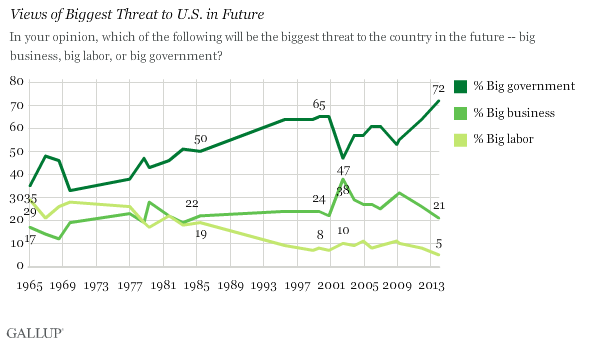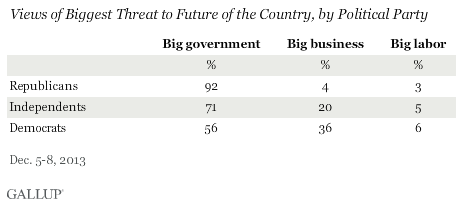
19 Dec, 2013
Gallup Poll: Record High in U.S. Say Big Government Greatest Threat, Snowden Revelations Seen as Factor
PRINCETON, NJ, Gallup Organisation (December 18, 2013) — Seventy-two percent of Americans say big government is a greater threat to the U.S. in the future than is big business or big labor, a record high in the nearly 50-year history of this question. The prior high for big government was 65% in 1999 and 2000. Big government has always topped big business and big labor, including in the initial asking in 1965, but just 35% named it at that time.

The latest update comes from a Dec. 5-8 poll. Gallup has documented a steady increase in concern about big government since 2009, rising from 55% in March 2009 to 64% in November 2011 and 72% today. This suggests that government policies specific to the period, such as the Affordable Care Act — perhaps coupled with recent revelations of government spying tactics by former NSA contractor Edward Snowden — may be factors.
Currently, 21% name big business as the greatest threat, while 5%, a record low, say big labor. The high point for big labor was 29% in 1965. No more than 11% of Americans have chosen big labor since 1995, clearly reflecting the decline of the labor movement in the United States in recent decades.
The historical high choosing big business, 38%, came in 2002, after a series of corporate scandals rocked major corporations including Enron and Tyco. Also at that time, Americans may have been less willing to choose government given the rally in support for government institutions and officials after the 9/11 terrorist attacks.
Americans were also more likely to view big business as a big threat during the recent recession, with more than three in 10 choosing it in 2008 and 2009, a time when many large corporations, including financial and automotive companies, failed or were in danger of failing without government intervention. But fewer Americans now view big business as a threat — the current 21% is the lowest Gallup has measured since 1983.
Republicans Especially Likely to See Big Government as Threat
Even though Americans have always viewed big government as the greatest threat, the degree to which they do so has varied. In recent decades, since the start of the Clinton administration, perceptions of big government as a threat have varied depending on the party of the president. Since Barack Obama took office in 2009, an average of 64% of Americans have named big government as the greatest threat. That is up from an average 56% during George W. Bush’s administration from 2001-2008, but similar to the 65% average from 1993-2000 during the Clinton administration.
This pattern is largely driven by Republicans, who generally are more likely to be concerned about the size and power of government, and this concern is amplified when a Democrat is president. Democrats are more likely to see government as a threat when a Republican is in office; however, they tend to see government as less threatening than Republicans do, and their concern about big government topped out at 62% in 2005 under Bush.

During the Johnson, Nixon, Carter, and Reagan administrations, party differences were much more modest than they are today.
Each party group currently rates big government as the greatest threat to the country, including a record-high 92% of Republicans and 71% of independents, as well as 56% of Democrats. Democrats are most likely of the partisan groups to name big business as the biggest threat, at 36%; relatively few Republicans, 4%, view big business as the most threatening.

Implications
Americans have consistently viewed big government as a greater threat to the United States than either big business or big labor, but never more than they do now. That may be partly a reaction to an administration that favors the use of government to solve problems. Also, the revelation of widespread government monitoring of U.S. Internet activity may be a factor in raising Americans’ concern about the government. The threat of big business may seem diminished now, during a relatively calm period for big business, with rising stock values and relatively few major corporate scandals such as occurred in the early 2000s. Also, the labor movement is far less influential in U.S. policy today than in the past, including in 1965, when Gallup first asked the question.
In the future, Americans likely will continue to view big government as the greatest threat of the three, partly because of Republicans’ reluctance to rely on government to solve problems, and because Democrats and independents are also inclined to view big government as a greater threat than big business or big labor. But the percentage of Americans viewing big government as the greatest threat will also likely to continue to vary, in response to current conditions in the political and business environments.
For results based on the total sample of national adults, the margin of sampling error is ±4 percentage points at the 95% confidence level.
Interviews are conducted with respondents on landline telephones and cellular phones, with interviews conducted in Spanish for respondents who are primarily Spanish-speaking. Each sample of national adults includes a minimum quota of 50% cellphone respondents and 50% landline respondents, with additional minimum quotas by region. Landline and cell telephone numbers are selected using random-digit-dial methods. Landline respondents are chosen at random within each household on the basis of which member had the most recent birthday.
Samples are weighted to correct for unequal selection probability, nonresponse, and double coverage of landline and cell users in the two sampling frames. They are also weighted to match the national demographics of gender, age, race, Hispanic ethnicity, education, region, population density, and phone status (cellphone only/landline only/both, and cellphone mostly). Demographic weighting targets are based on the March 2012 Current Population Survey figures for the aged 18 and older U.S. population. Phone status targets are based on the July-December 2011 National Health Interview Survey. Population density targets are based on the 2010 census. All reported margins of sampling error include the computed design effects for weighting.
In addition to sampling error, question wording and practical difficulties in conducting surveys can introduce error or bias into the findings of public opinion polls.
For more details on Gallup’s polling methodology, visit www.gallup.com.



Liked this article? Share it!